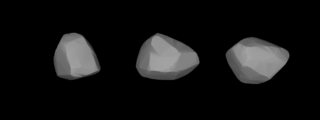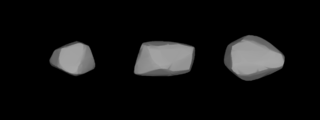
Vincentina is a fairly large main belt asteroid.

Ilse is a Main belt asteroid. It has an unusually slow rotation period, about 3.5 days.

Valda is a main belt asteroid that was discovered by Austrian astronomer Johann Palisa on 3 November 1886 in Vienna. The name was proposed by Bettina von Rothschild.

Dresda is a typical Main belt asteroid. It belongs to the Koronis family of asteroids.

Senta is a minor planet orbiting the Sun that was discovered by German astronomer Max Wolf on 16 November 1904, from Heidelberg.
Bilkis is a minor planet, specifically an asteroid orbiting in the asteroid belt. It was discovered by German astronomer August Kopff in 1906 February and was given the Koran name for the Queen of Sheba. Photometric observations at the Palmer Divide Observatory in Colorado Springs, Colorado in 2006–7 were used to build a light curve for this object. The asteroid displayed a rotation period of 8.5742 ± 0.0005 hours and a brightness variation of 0.40 ± 0.02 in magnitude.
Thekla is a minor planet orbiting the Sun. It was named after Saint Thecla of the first century. The name may have been inspired by the asteroid's provisional designation 1906 TC.

Tomyris is a minor planet orbiting the Sun. Its name derives from the Massagetean ruler Tomyris, and may have been inspired by the asteroid's provisional designation 1906 TO.
Irmgard is a minor planet orbiting the Sun.
Titania is a minor planet orbiting the Sun. The name may have been inspired by the asteroid's provisional designation 1906 TT.

Polyxena is a minor planet orbiting the Sun. This main belt asteroid was discovered on 27 March 1906 by German astronomer August Kopff at the Heidelberg observatory. It was named after the youngest daughter of Priam and Hecuba, king and queen of Troy during the Trojan War. 595 Polyxena is orbiting at a distance of 3.21 AU from the Sun, with an orbital eccentricity (ovalness) of 0.06 and a period of 5.75 yr (2,099.1 d). The orbital plane is inclined at an angle of 17.8° to the ecliptic.
Octavia is a minor planet orbiting the Sun. At 15:45 UTC on October 6, 2014, the 13.5 magnitude asteroid occulted with magnitude 8.1 TYC 1299-00020-1, and was visible in Taiwan.

Juvisia is a minor planet, specifically an asteroid orbiting in the asteroid belt that was discovered 27 August 1906 in Heidelberg by German astronomer Max Wolf. It was named after the commune Juvisy-sur-Orge, France, where French astronomer Camille Flammarion had his observatory.
607 Jenny is a minor planet, specifically an asteroid orbiting in the asteroid belt that was discovered by German astronomer August Kopff on September 18, 1906.
616 Elly is a minor planet orbiting the Sun. It is a member of the Maria family of asteroids.
618 Elfriede is a minor planet orbiting the Sun. On July 24, 2013, it occulted the magnitude 12.8 star 2UCAC 23949304, over parts of Mexico and southwestern United States.
619 Triberga is a main belt asteroid discovered on 22 October 1906 by August Kopff at Heidelberg-Königstuhl State Observatory. Since it has an orbit that repeats itself almost exactly every four years with respect to the position of the Sun and Earth, it has been suggested as a way to calculate the mass of the Moon. Triberga was named for the German town of Triberg.
620 Drakonia is a minor planet, specifically an asteroid orbiting in the asteroid belt. It was discovered October 26, 1906, in Taunton, Massachusetts, by American astronomer Joel Hastings Metcalf and given the preliminary designation 1906 WE. It may have been named for Drake University.
768 Struveana is a minor planet orbiting the Sun. The asteroid was named jointly in honor of Baltic German astronomers Friedrich Georg Wilhelm von Struve, Otto Wilhelm von Struve and Karl Hermann Struve.
6144 Kondojiro (1994 EQ3) is an asteroid discovered on March 14, 1994 by Kin Endate and Kazuro Watanabe at the Kitami Observatory in eastern Hokkaidō, Japan. It is named after Jiro Kondo, a Japanese Egyptologist and professor of archaeology at Waseda University.








